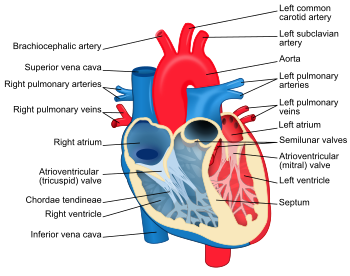
Saturday, April 17, 2010
Structure of heart
The heart is enclosed in a double-walled sac called the pericardium. The superficial part of this sac is called the fibrous pericardium. This sac protects the heart, anchors its surrounding structures, and prevents overfilling of the heart with blood. It is located anterior to the vertebral column and posterior to the sternum. The size of the heart is about the size of a fist and has a mass of between 250 grams and 350 grams. The heart is composed of three layers, all of which are rich with blood vessels. The superficial layer, called the visceral layer, the middle layer, called the myocardium, and the third layer which is called the endocardium. The heart has four chambers, two superior atria and two inferior ventricles. The atria are the receiving chambers and the ventricles are the discharging chambers. The pathway of blood through the heart consists of a pulmonary circuit and a systemic circuit. Blood flows through the heart in one direction, from the atrias to the ventricles, and out of the great arteries, or the aorta for example. This is done by four valves which are the tricuspid atrioventicular valve, the mitral 
 Structure diagram of the human heart. Blue components indicate de-oxygenated blood pathways and red components indicate oxygenated pathways. The heart is enclosed in a double- atrioventicular valve, the aortic semilunar valve, and the pulmonary semilunar valve.[
Structure diagram of the human heart. Blue components indicate de-oxygenated blood pathways and red components indicate oxygenated pathways. The heart is enclosed in a double- atrioventicular valve, the aortic semilunar valve, and the pulmonary semilunar valve.[

Subscribe to:
Post Comments (Atom)



0 comments:
Post a Comment